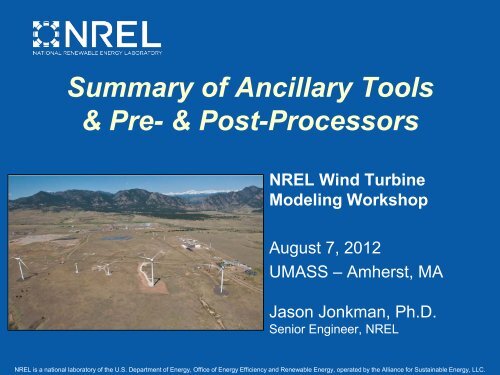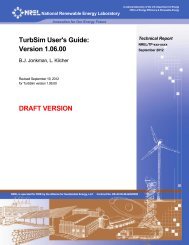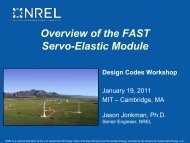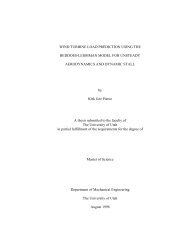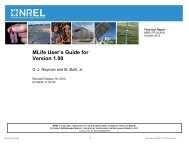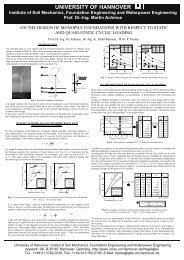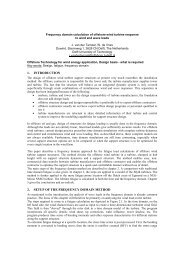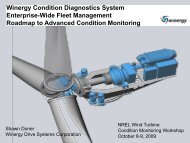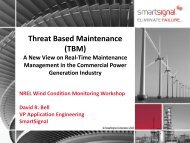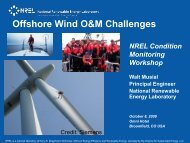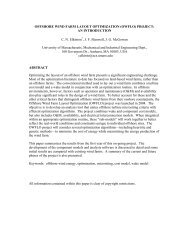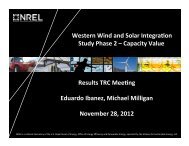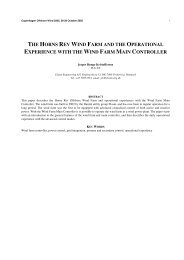NREL Wind Turbine Modeling Workshop
NREL Wind Turbine Modeling Workshop
NREL Wind Turbine Modeling Workshop
- No tags were found...
Create successful ePaper yourself
Turn your PDF publications into a flip-book with our unique Google optimized e-Paper software.
Outline• Key <strong>NREL</strong> Codes in the Design Process• AirfoilPrep• TurbSim• PreComp• NuMAD• BModes• WT_Perf & HARP_Opt• MSC.ADAMS, A2AD, & FAST-to-ADAMS• MCrunch, MExtremes, & MLife• MBC3• NWTC Subroutine Library• Automation Scripts<strong>Wind</strong> <strong>Turbine</strong> <strong>Modeling</strong> <strong>Workshop</strong> 2 National Renewable Energy Laboratory
Design CodesTurbSim• Computes full-field stochastic wind realizations:– Inputs are desired wind profile & turbulence characteristics– Includes IEC- & site-specific turbulence models– Option to generate coherent structures from LES & DNS output• Current & planned work – Add option for periodic wind for longtime series• Future opportunities:– Apply code to determine impactof non-IEC turbulence on turbineresponse– Include additional site-specificturbulence models– Add Mann modelFull-Field Turbulence GridsB. Jonkman, <strong>NREL</strong><strong>Wind</strong> <strong>Turbine</strong> <strong>Modeling</strong> <strong>Workshop</strong> 5 National Renewable Energy Laboratory
<strong>Wind</strong> <strong>Turbine</strong> <strong>Modeling</strong> <strong>Workshop</strong> 6 National Renewable Energy LaboratoryDesign CodesPreComp• Computes coupled sectionproperties of composite bladesfor beam-type models:– Inputs are the airfoil shape & internallay-up of composite laminas– Uses a combined laminate theory(modified) with shear flow approach• Current & planned work – Furtherverification against NuMAD &VABS• Future opportunities:– Add stress analysis– Add inverse design algorithm⎧FX⎫ ⎡EASaf Sal Sat⎤⎧ue' ⎫M⎢⎥YSafEIflapSflSftw"⎪ ⎪ ⎪ ⎪⎨ ⎬= ⎢ ⎥ ⎨ ⎬⎪MZ ⎪⎢SalSflEIlagS ⎥lt ⎪v"⎪⎪⎢⎥⎩T⎪X ⎭ ⎢⎣Sat Sft SltGJ⎥⎩ ⎦⎪θ' ⎪⎭G. Bir, <strong>NREL</strong>
<strong>Wind</strong> <strong>Turbine</strong> <strong>Modeling</strong> <strong>Workshop</strong> 7 National Renewable Energy LaboratoryDesign CodesNuMAD• A GUI pre- & post-processor for ANSYS-based blade analysis:– Developed by SNL– Lay-up of composite laminas & webs– Enables one to create a 3D FEA model & perform structural analysis– “Beam propertyextraction” featureto produce sectionproperties forbeam-type models– Load mapping forstress recovery– Plot3D output forCFD mesh• Futureopportunities –Industry requestsB. Resor, SNL
Design CodesBModes• Computes coupled mode shapes & frequencies of blades & towers:– Inputs are the boundary conditions & distributed isotropic beam properties– Considers axial-flap-lag-torsion coupling– Uses a 15-DOF FE specially developed to handle rotation-related terms– Boundary conditions include towers with flexible foundations or floating bases• Current & planned work:– Replace with FE formulation in FAST• Future opportunities:– Add gravitational destiffening totower model– Compute mode shapes aboutloaded deflection– Allow for anisotropic material(from PreComp, NuMAD, or VABS)– Allow for built-in curvature & sweep<strong>Wind</strong> <strong>Turbine</strong> <strong>Modeling</strong> <strong>Workshop</strong> 8 National Renewable Energy Laboratory
Design CodesWT_Perf & HARP_Opt• WT_Perf calculates steady-state rotor performance:– Inputs are rotor geometry, airfoil data, wind, pitch, & rotor speed– Uses BEM theory• HARP_Opt optimizes rotorperformance:– MATLAB-based wrapper of WT_Perf– Uses GA to design rotor geometry foroptimal aerodynamic efficiency (AEP)• Current & planned work:– Improve solution algorithm• Future opportunities:– Import AirfoilPrep features– Add algorithm for tuning airfoil data tomatch measured performance– Incorporate new aerodynamic models(e.g., vortex wake)K. Johnson, <strong>NREL</strong>Power Coefficient for the CART2<strong>Wind</strong> <strong>Turbine</strong> <strong>Modeling</strong> <strong>Workshop</strong> 9 National Renewable Energy Laboratory
Design CodesMSC.ADAMS, A2AD, & FAST-to-ADAMS• Computes structural-dynamic & control-system responses as part of theaero-hydro-servo-elastic solution:– Commercial product from MSC Software– Uses a multi-body representation with virtually unlimited DOFs– Controls through subroutines or DLLs– Nonlinear time-domain solution for loads analysis– Linearization of nonrotating system– Coupled to AeroDyn & HydroDyn through A2AD– Datasets can be created by FAST– Bypasses some limitations of FAST– Evaluated by Germanischer Lloyd <strong>Wind</strong>Energie• Current & planned work:– Enable compatibility with the ADAMS C++ solver– Restructure A2AD for improved numericalprocessing of fluid-structure interaction– Improve modeling pre-curved & pre-swept blades• Future opportunities:– Replace rigid with flex bodies (imported from FEA)– Utilize linearization in a rotating frame– Model gearboxes in detailADAMS Model Created by FAST<strong>Wind</strong> <strong>Turbine</strong> <strong>Modeling</strong> <strong>Workshop</strong> 10 National Renewable Energy Laboratory
<strong>Wind</strong> <strong>Turbine</strong> <strong>Modeling</strong> <strong>Workshop</strong> 11 National Renewable Energy LaboratoryDesign CodesMCrunch, MExtremes, & MLife• MATLAB-based postprocessors• MCrunch for general dataanalysis:– Merges features from legacy codes(Crunch, GPP, GenStats, &Fatigue):• Scales, offsets, & calculated channels• Statistics• Probability density functions• Power spectral density• Extreme event tables• Rainflow counting, DELs, & lifetimedamage• Plotting– Processes all data files togetherPSD of RotTorq410 810 61010 210 010 -210 -410 -610 -80 1 2 3 4 5Frequency, Hz6 7 8 9 10Cum. Cycles per Second10 110 010 -10 100 200 30010 2 RootFMxy1 Range (kN)PDF, (m) -11.510.5GenPwr (kW)4000350030002500200015001000OoPDefl1 (m)50001 2 3 4 5 6 7 8 9 10 11<strong>Wind</strong>Vxi (m/sec)50-520 40 60 80 100Time (sec)00 0.5 1 1.5 2 2.5 3WaveElev (m)Example Outputs from MCrunch
Design CodesMCrunch, MExtremes, & MLife (cont)• MExtremes for extreme-event tables:– Processes data files independently– Scales, offsets, PSFs, & calculated channels– Statistics– Peak finding• MLife for fatigue-life analysis:– Processes data files independently– Scales, offsets, PSFs, & calculated channels– Statistics– Rainflow counting, DELs, & lifetime• Current & planned work:– Develop consistency across tools & releasebeta versions• Future opportunities:– Filtering, load roses, azimuth averages,statistical extrapolation, etc.Lifetime Cycles of In-PlaneBlade-Root Bending Moment PerSimulation<strong>Wind</strong> <strong>Turbine</strong> <strong>Modeling</strong> <strong>Workshop</strong> 12 National Renewable Energy Laboratory
<strong>Wind</strong> <strong>Turbine</strong> <strong>Modeling</strong> <strong>Workshop</strong> 13 National Renewable Energy LaboratoryDesign CodesMBC3• A MATLAB-based postprocessor forMulti-Blade-Coordinate transformation:– Accepts FAST linearization output as input– Transforms cumulative dynamics of spinningrotor blades into the nonrotating frame– Handles system, controls, &Ydisturbance matrices for states &NRoutputs– Applicable to controls design & stabilityanalysis for 3-bladed rotors• Future opportunities:– Extend formulation to more than 3 blades– Develop Floquet-based tools for 2 bladers– Establish stability guidelines for turbinedesignersZ NRψ bBirX NRblade bRotor disk
Design CodesNWTC Subroutine Library• Contains general-purpose routines for use by all codes:– I/O, math, aerodynamic, & compiler-specific routines– Used by most of the NWTC codes– Reduces development & maintenance time• Current & planned work:– Make fully compatible with UNIX/Linux– Develop new libraries for numerical methods:• Iterative root finders• ODE & DAE time-integrators• Future opportunities:– Develop new libraries for numerical methods:• FFT routines• Linear equation solvers• Eigensolvers<strong>Wind</strong> <strong>Turbine</strong> <strong>Modeling</strong> <strong>Workshop</strong> 14 National Renewable Energy Laboratory
Design CodesAutomation Scripts• Three scripts available on the web site:– RunIEC: Runs IEC<strong>Wind</strong>, FAST, & Crunch for IEC discrete load cases– RunNTM: Runs TurbSim, FAST, & Crunch for multiple turbulence cases– CondorNTM: Same as RunNTM, but uses Condor– All written in Perl; must know a little Perl to modify– No further development planned• Have an in-house script also called RunIEC:– Combined features from all three of the above scripts– Tailored to IEC-style load cases– Runs jobs serially, on Condor pool, or on HPC (multi-processor server)– Currently requires significant customization to use• Current & planned work:– Make in-house RunIEC user friendly, write manual, & distribute– Add option for customizable load cases (parametric or combined-caseanalyses)– Use for loads analysis & uncertainty quantification (UQ)<strong>Wind</strong> <strong>Turbine</strong> <strong>Modeling</strong> <strong>Workshop</strong> 15 National Renewable Energy Laboratory
Questions?Jason Jonkman, Ph.D.+1 (303) 384 – 7026jason.jonkman@nrel.gov<strong>NREL</strong> is a national laboratory of the U.S. Department of Energy, Office of Energy Efficiency and Renewable Energy, operated by the Alliance for Sustainable Energy, LLC.


